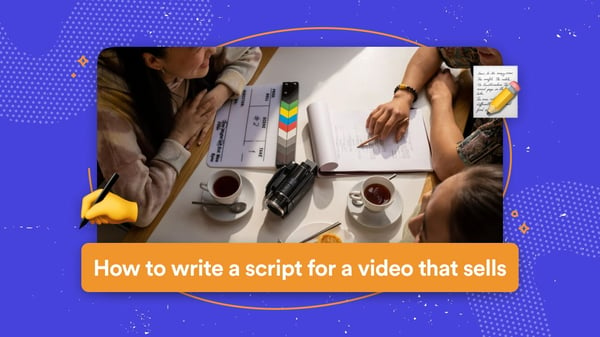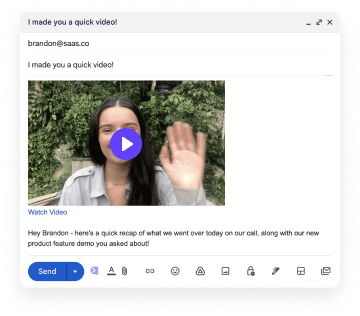Marketing teams are always on the hunt for better and more creative ways to reach their audiences. One such way is by creating video content that helps grab attention, drives engagement, and ultimately seals the deal with a sale. But how do you write a script for a video that can successfully drive growth without coming off as overly sales-y?
In this blog post, we'll explore some key strategies for writing scripts that not only illustrate your product or service in an objective manner but also make customers feel like they're part of something bigger.
From defining customer needs to establish brand value, discover how to craft compelling story arcs and language patterns suited specifically to video marketing campaigns.
The benefits of video marketing
- The most efficient approach to begin connecting with your target audience
- Video marketing helps "humanize" the brand
- Video content improves the SEO performance of a website
- The perfect way to increase customer trust
- The best way to attract the attention of lazy customers
So, video marketing has huge potential, because with it you can achieve high engagement of the audience, increase brand loyalty, and consequently increase sales.
Start by understanding your target audience
Knowing the unique motivations, difficulties, and preferences of your customers can help you craft an effective message that resonates with them. Understanding the target audience allows for customizing the script to match their specific needs, which leads to a more successful video in terms of conversions and viewers.
1. Define the product or service.
The first step in determining the target audience for a video is to define the product or service that is being sold. What are the product's or service's characteristics and benefits? Once the product or service has been defined, it will be easier to identify potential customers.
2. Research potential customers.
The next step is to research potential customers. Who is the most probable customer for the product or service? What is their demographic? What are their interests?
This information can be gathered through market research or by using data from previous marketing campaigns.
3. Create a buyer persona.
Once the target audience has been identified, a buyer persona can be created. A buyer persona is a fictional character that represents the ideal customer for a product or service. The persona should include information such as age, gender, location, interests, and needs. This information will help to create a more targeted video that resonates with the audience.
Sales Script: How to make a good video script
The script is the prescribed structure of the video. It consists of three elements:
- The text part - a monologue or dialogue for the speaker, actors, or narrator.
- Visual images - notes about how everything will look in the frame: the description of the location, colors, visual accents, and props.
- The technical part: here you specify, for example, the speed and tone of speech, music, transitions from frame to frame, and other details. The technical part is taken by experts from the production team, at the stage of creating the script to give general notes for guidance.
(👉 8 proven examples of video scripts for sales prospecting)
The Text Part: Draft a storyboard that lays out the video's plot and flow
A storyboard is meant to provide an outline of the video, organizing key visuals and information into a linear sequence.
Therefore, the storyboard should consist of the following parts:
- Introduce the video and its purpose
- Outline the plot of the video, including key scenes and dialogue
- A description of how the video will flow, including transitions between scenes.
- Selection of music and special effects to be used in the video.
- Summarize the tone and overall feel of the video
- A brief conclusion
It can also be used to create shot lists, giving an idea of what the camera should capture while it’s filming. Additionally, having this precursor will help ensure that vendors and other production experts understand what your vision is for the complete product.
Ultimately, having a well-thought-out storyboard not only ensures that all involved in the production process are on the same page but also gives you a solid foundation upon which to build your video.
The sales script consists of three parts: the plot, the conceptual block, and the call to action (CTA).
It is better to work through them in reverse order so that you know in advance what to prepare the viewer for.
Call to action
Start with the selection and wording of the CTA. Knowing what the customer should do after watching the video, you can properly lead them to this action through the previous blocks.
How to increase CTA conversions:
- Add bonuses. Reward the viewer for taking targeted action. If the customer understands that a gift is waiting for them, they are more willing to do what is called for in the video. As a bonus, offer useful materials (checklists, guides, picks, exclusive videos or recordings of broadcasts) or direct use of the product (test subscription, free week at the gym, first lesson from the course).
- Introduce limits. Use time or quantity limits on products. For example, tell the video that there are only ten spots left for the webinar; the collection is limited; the discount is only valid for three days.
- Use psychological triggers. These are triggers that trigger reactions in the brain that prompt action.
The meaning block of a selling video
A meaningful selling video is a fact that increases brand credibility and reinforces the desire to take the targeted action.
Meaningfulness helps to expose your business to the customer in a beneficial way. For example, to show experience through information about the number of years in the market and successful deals.
The meaning block of a selling video
Meaning in a selling video is a fact that increases brand credibility and strengthens the desire to take the targeted action.
Meaningfulness helps to expose your business to the customer in a beneficial way. For example, to show experience through information about the number of years in the market and successful deals.
People are primarily interested in themselves, so most of the time should focus on what is important to the customer.
To make a decision, the viewer should get to know the product from the position of "why it will be useful for me, why I need it"; get to know themselves in the target audience of the company. Allocate the bulk of the script (80%) to the story about what and for whom you are selling. The remaining 20% is the "seasoning" of credibility-boosting facts: awards, expertise, numbers of achievements, and media mentions.
It is important not only to convey information in words but also to visualize it in the frame, to confirm it with examples.
Answer five questions:
- Who are we?
- What do we sell?
- Why do our customers need our product?
- Why should they buy from us and not from others?
- Why should we buy now and not later?
The plot of the selling video
The typical user has an attention span of 8 seconds. The abundance of information and constant "bombardment" with stimulating formats decreases it more and more. If you don't manage to interest the client in the first few seconds, he simply closes the video. It's very important not to miscalculate at the beginning.
Where to start the video:
- Greetings. It makes sense to say hello to the viewer first, but politeness alone won't get him hooked. A greeting should be combined with provocative questions or a reference to the client's pain. Great if the founder, CEO of the company, or other important people in management are in the frame. This sets a more trusting tone.
- Feedback. If you have a "killer" review, you can not wait for the concept block, and start immediately with the client's opinion.
- Trailer. Use a snippet of highlights of your product or service to hold attention. Good for products that give a dynamic picture. For example, motorcycle stunts in a motorcycle school commercial.
- Demonstration of the result. Start the commercial by showing how quickly your product solves the customer's problem. For example, it removes carpet stains in five seconds.
- Provocative question. A universal option for a starter, suitable for almost every business. It is usually combined with a greeting and a customer's pain. The question itself most often has a reference to a problem that the person can't solve, but really wants to do so. For example: "Tired of hiding your teeth when you smile?"
Shoot a test video to get feedback
Shooting a test video is a great way to get feedback on your project before it's finished. It also allows you to make necessary adjustments during production, saving time and money in the long run. Not only will a test video help viewers understand the concept better, but it can be used as a way to ensure that everyone involved in the production is on the same page about what needs to happen. Having quality feedback throughout the process can lead to better-made projects and more successful outcomes.
- The video must be shot in high resolution! Full HD (Full High Definition) means a resolution of 1920×1080 dots (pixels) and a frame rate of at least 24 / sec. This is a very important point because high resolution makes your business more professional in the eyes of the client.
- Videos that tell powerful stories about a brand or product should not go beyond 60 seconds.
- Don't tell viewers unnecessarily long stories; they're more likely to turn off the video.
- Always strive to evoke emotion in the viewer.
- Taking a targeted action is always based on emotion, the more emotion a person gets from your video, the more likely they are to take the targeted action.
- Sound quality should always be top-notch because it has a huge impact on the people watching the video. If the sound quality is poor, chances are the person will turn off the video in the first 10 seconds.
- Leave a call to action (CTA) at the end of each video. This will drive more sales through the video.
- The ideal length of a video, depending on the social network:
- Instagram - 30 seconds
- Twitter - 45 seconds
- Facebook - 1 minute
- YouTube - 2 minutes.
- And don't forget the call to action, which on YouTube usually consists of a short summary inviting users to subscribe to the channel.
Use music and sound effects that are appropriate for the tone of your video
In order to engage viewers and create a video that is visually appealing, it is important to use music and sound effects that are appropriate for the tone of the video.
For example, if the video is meant to be light-hearted and funny, using an upbeat song with a fast tempo will help set the tone. Alternatively, if the video is meant to be more serious, using a slower song with a melancholy tone will convey this message to viewers. Sound effects can also be used to highlight certain points or transitions in the video.
For instance, using a sound effect when a character appears on screen for the first time can help grab the viewer's attention. Overall, utilizing music and sound effects that fit the tone of the video will help create an enjoyable and engaging experience for viewers.
Wrapping up video scripts
We have now covered a lot of ground when it comes to creating compelling and successful sales videos with scripts. Crafting a great script for a sales video is something that takes effort, skill, and diligence but if done properly can ensure that your product or service will shine and become visible in this ever-crowded digital space.
Once you are ready to start recording, head on over to Sendspark to create your free account.
With Sendspark, you can easily record videos of yourself or your screen to share with customers or potential customers. All videos can be branded with your logo, and shared in email email or messaging platform. You'll have dynamic personalization to scale your outreach, and detailed analytics to prove it's working.
Happy recording!




